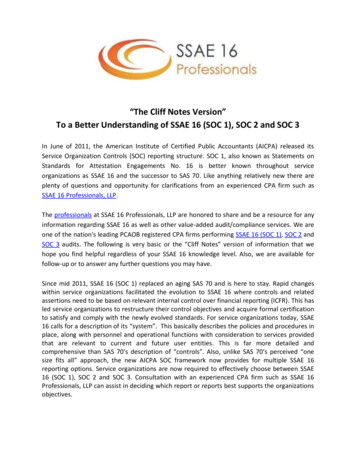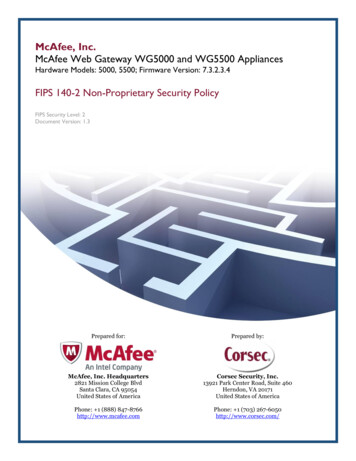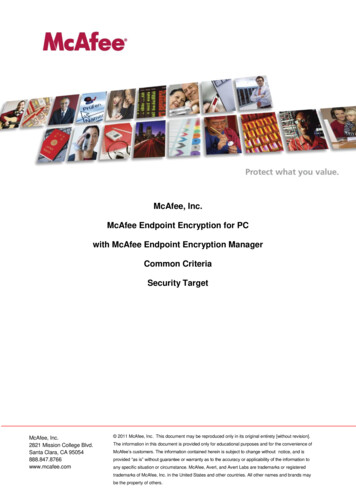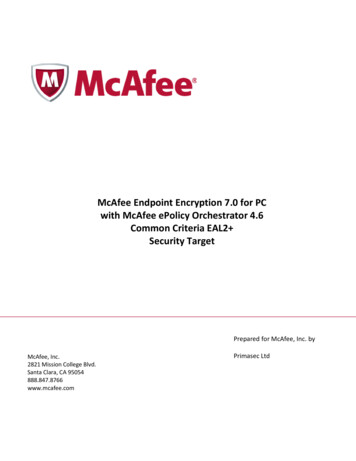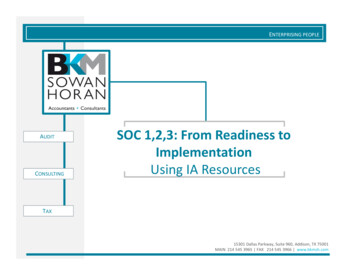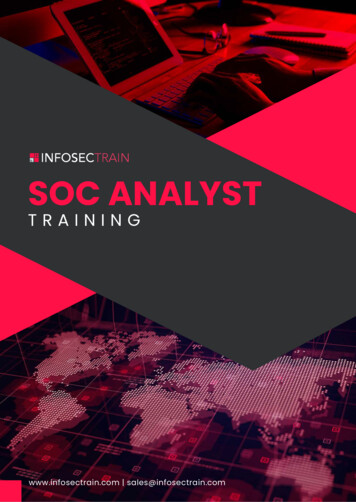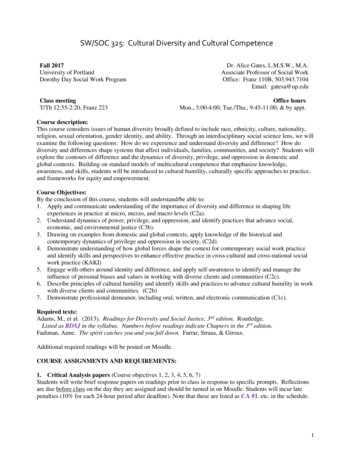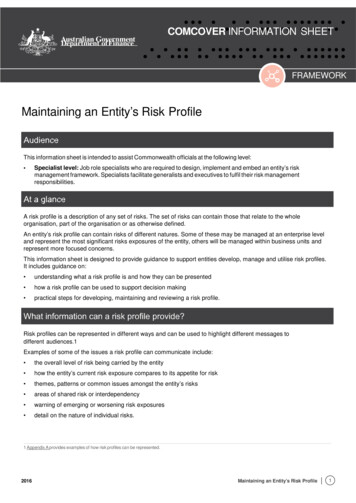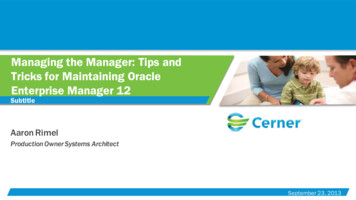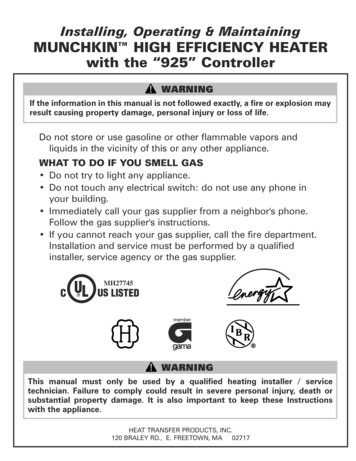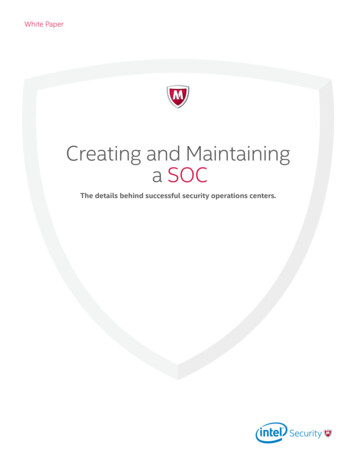
Transcription
White PaperCreating and Maintaininga SOCThe details behind successful security operations centers.
White PaperTable of ContentsIntroduction. . . . . . . . . . . . . . . . . . . . . . . . . . . . . . . . . . . . . . . . . . . . . . . . . . . . . . . . . . . . . . . . . . . . . . . . . . . . . . . . . . . . . . . . 3Define the Security Operations Center. . . . . . . . . . . . . . . . . . . . . . . . . . . . . . . . . . . . . . . . . . . . . . . . . . . . . . . . . . . . . . 3This white paper was written by:McAfee Foundstone Professional ServicesDetermine the Processes. . . . . . . . . . . . . . . . . . . . . . . . . . . . . . . . . . . . . . . . . . . . . . . . . . . . . . . . . . . . . . . . . . . . . . . . . . . 4Required templates. . . . . . . . . . . . . . . . . . . . . . . . . . . . . . . . . . . . . . . . . . . . . . . . . . . . . . . . . . . . . . . . . . . . . . . . . . . . . . 5Reporting process. . . . . . . . . . . . . . . . . . . . . . . . . . . . . . . . . . . . . . . . . . . . . . . . . . . . . . . . . . . . . . . . . . . . . . . . . . . . . . . 5Understand the Environment. . . . . . . . . . . . . . . . . . . . . . . . . . . . . . . . . . . . . . . . . . . . . . . . . . . . . . . . . . . . . . . . . . . . . . . 5Developing Use Cases. . . . . . . . . . . . . . . . . . . . . . . . . . . . . . . . . . . . . . . . . . . . . . . . . . . . . . . . . . . . . . . . . . . . . . . . . . . 6Identify the Customer . . . . . . . . . . . . . . . . . . . . . . . . . . . . . . . . . . . . . . . . . . . . . . . . . . . . . . . . . . . . . . . . . . . . . . . . . . . . . . 7Staff the SOC. . . . . . . . . . . . . . . . . . . . . . . . . . . . . . . . . . . . . . . . . . . . . . . . . . . . . . . . . . . . . . . . . . . . . . . . . . . . . . . . . . . . . . . 7Staffing schedule. . . . . . . . . . . . . . . . . . . . . . . . . . . . . . . . . . . . . . . . . . . . . . . . . . . . . . . . . . . . . . . . . . . . . . . . . . . . . . . . 7Holiday coverage. . . . . . . . . . . . . . . . . . . . . . . . . . . . . . . . . . . . . . . . . . . . . . . . . . . . . . . . . . . . . . . . . . . . . . . . . . . . . . . . 8Shift logs, incident logs, and turnover. . . . . . . . . . . . . . . . . . . . . . . . . . . . . . . . . . . . . . . . . . . . . . . . . . . . . . . . . . . . 8Event Management. . . . . . . . . . . . . . . . . . . . . . . . . . . . . . . . . . . . . . . . . . . . . . . . . . . . . . . . . . . . . . . . . . . . . . . . . . . . . . . . . 9Incident assignment, update, and escalation. . . . . . . . . . . . . . . . . . . . . . . . . . . . . . . . . . . . . . . . . . . . . . . . . . . 10Security severity. . . . . . . . . . . . . . . . . . . . . . . . . . . . . . . . . . . . . . . . . . . . . . . . . . . . . . . . . . . . . . . . . . . . . . . . . . . . . . . 10Incident and event categorization. . . . . . . . . . . . . . . . . . . . . . . . . . . . . . . . . . . . . . . . . . . . . . . . . . . . . . . . . . . . . . 11Incident resolution and escalation procedures. . . . . . . . . . . . . . . . . . . . . . . . . . . . . . . . . . . . . . . . . . . . . . . . . 11Third-party resolution and escalation procedures. . . . . . . . . . . . . . . . . . . . . . . . . . . . . . . . . . . . . . . . . . . . . . 13Incident escalation contact list. . . . . . . . . . . . . . . . . . . . . . . . . . . . . . . . . . . . . . . . . . . . . . . . . . . . . . . . . . . . . . . . . 13Escalation guidelines. . . . . . . . . . . . . . . . . . . . . . . . . . . . . . . . . . . . . . . . . . . . . . . . . . . . . . . . . . . . . . . . . . . . . . . . . . 13Tier functional responsibilities. . . . . . . . . . . . . . . . . . . . . . . . . . . . . . . . . . . . . . . . . . . . . . . . . . . . . . . . . . . . . . . . . 14Leveraging the IT Infrastructure Library (ITIL) Service Management Lifecycle. . . . . . . . . . . . . . . . . . . . . . 14Conclusion . . . . . . . . . . . . . . . . . . . . . . . . . . . . . . . . . . . . . . . . . . . . . . . . . . . . . . . . . . . . . . . . . . . . . . . . . . . . . . . . . . . . . . . 15References . . . . . . . . . . . . . . . . . . . . . . . . . . . . . . . . . . . . . . . . . . . . . . . . . . . . . . . . . . . . . . . . . . . . . . . . . . . . . . . . . . . . . . . 15About McAfee Foundstone Professional Services. . . . . . . . . . . . . . . . . . . . . . . . . . . . . . . . . . . . . . . . . . . . . . . . . 16Creating and Maintaining a SOC2
White PaperIntroductionSecurity is becoming more and more established in the corporate structure—it is no longeracceptable for security to be a secondary function of an IT department. To address this challenge,organizations are investing in the development of security operations centers (SOCs) to provideincreased security and rapid response to events throughout their networks. Building a SOC can bea monumental task. Although the finer points of SOC deployment are very much network-specific,there are several major components that every organization must include: people, process, andtechnology. The three exist in all elements of security and should be considered equally criticalcomponents. This paper explains how strong people and well-defined processes can result in anoperationally effective SOC.Proper planning is critical in the development and implementation phases. As with many securityprograms an iterative process is most effective in developing a refined set of procedures. Thisapproach will allow an organization to more quickly recognize benefits from their investment,positioning them to take advantage of knowledge gained and lessons learned through theactual operation of the SOC. It is important to set appropriate expectations and timelines for thedeployment of the SOC so the initial operational period is viewed as a period for refinement.The primary components of a SOC reviewed in this paper are: Define the security operations center—Establish the mission, responsibility, and scopeof the SOC.Determine the processes—Identify and clearly document key templates, procedures,and processes required to support the SOC.Understand the environment—Determine the technical domain to be monitored, the“use cases,” and the type of data that is received by the SOC. Identify the customer—Determine the classes of customers and their interaction withthe SOC. Staff the SOC—Define the operational hours and the required staff per shift. Manage the events—Categorize, assign, and prioritize events received by the SOC. Leveraging ITIL—Understand the core ITIL components to continually run aneffective SOC.Define the Security Operations CenterThe first and most important component when implementing a SOC is to define the mission, charter,objectives, and responsibilities. Defining these core items will ensure its longevity and help avoidconflict with other companywide functions. To begin, create a SOC manual that formally documentseach of the following items:Creating and Maintaining a SOC Mission Charter Objectives Responsibilities Operational Hours3
White PaperThis manual will continually be used as a reference for the SOC staff and management. Thedefinition statement should be clear and provide specific detail as described in the belowexample statement:“The SOC is responsible for monitoring, detecting, and isolating incidents and themanagement of the organization’s security products, network devices, end-user devices,and systems. This function is performed seven days a week, 24 hours per day. The SOC isthe primary location of the staff and the systems dedicated for this function.”The above example may not be comprehensive for some organizations and should be expandedupon with more specific details based on your organization’s mission and objectives. Once theresponsibility definition has been documented, a list of service functions for the SOC must bedefined. These may include:Service Functions Status Monitoring and Incident Detection.–– SIEM Console.–– AV Console.–– IPS Console.–– DLP Console. Initial Diagnostics and Incident Isolation. Problem Correction. Security Systems and Software.–– Update and test DAT definitions.–– Apply corrective IDS/IPS and Firewall Rules.–– Apply other corrective software as instructed or required. Computing Equipment and Endpoint Devices.–– Remote administration.–– Update antivirus.–– Tune HIPS alerts.–– Configure whitelisting. Work with Third-Party Vendors. Escalation to Next Tier Level. Closure of Incidents.–– Coordination with tier levels.–– Coordination with end users and system administrators. Persistent Threat Investigation.The service functions, once defined, will guide the daily processes and procedures for the SOC staff.Once each service is defined, each tier within the SOC can be assigned a series of responsibilitiesbased on each individual’s expertise within the tier level. For example, monitoring the antivirus (AV)and security information and event management (SIEM) console may be a service function of everytier; however working with third-party vendors may be a service function only reserved for tier 2 ortier 3 SOC staff. Once each service function is defined, a series of documents must be developedto ensure the appropriate information is gathered during an event or incident and to ensureconsistency across all SOC staff.Determine the ProcessesThe number of processes and procedures for a SOC is determined by its scope, how many servicesare offered, the number of customers supported, and the number of different technologies inuse. An established global SOC environment may have tens or even hundreds of procedures. At aminimum, the basic procedures that are required for maintaining the SOC are:Creating and Maintaining a SOC Monitoring procedure. Notification procedure (email, mobile, home, chat, etc.). Notification and escalation processes. Transition of daily SOC services. Shift logging procedures. Incident logging procedures. Compliance monitoring procedure. Report development procedure. Dashboard creation procedure. Incident investigation procedures (malware, etc.).4
White PaperMany of the procedures listed above may need to be customized based on the type of technologyin use. For example, a monitoring procedure for McAfee Enterprise Security Manager—the Intel Security SIEM solution—would be very different than the monitor procedure for another vendor’sSIEM product, although they share some of the same characteristics.Required templatesA series of baseline templates should be created to help maintain documentation consistency byestablishing the same format and basic information sets across policy and procedure documents.For example, templates for proper data input into ticketing systems and the GRC system will need tobe developed to help ensure the appropriate technical information is gathered. A few key templatesrequired are: Shift log templates for each use case. Templates for each incident trouble ticket category.Reporting processAs a primary function, regular reports will need to be generated and provided to different audienceswithin the organization. Usually a weekly report is prepared for incidents, detailing the activity withinthe SOC. These reports can be delivered to management and other members on the core escalationcontact list.The SOC manager should review all incident records regularly to ensure they were resolved withinthe parameters of the defined severity levels. The manager should also audit incident recordsthat have exceeded standard resolution times to validate that the incident records were handledappropriately. The SOC processes and procedures should be reviewed regularly and updated basedon the report data reviews and audits. In addition, many other reports can be created depending onthe type of data received or requested by management.For a very detailed list of reports, refer to the “Operationalizing Information Security Putting the Top10 SIEM Best Practices to Work” by Scott Gordon in the references section. Among these items areother key reports to measure staff on, including: Shift log metrics. Trouble Ticket metrics.Understand the EnvironmentWithout an understanding of the technical environment, it will be difficult to investigate and tounderstand if an actual attack has occurred. For this reason, the staff within the SOC must have theappropriate tools, diagrams, and knowledge of the network to perform their daily job. It is importantto have both an electronic and a hard copy of the key network and application architecture diagrams.For any new SOC staff, navigating and understanding the environment should be included as partof their required basic training. This will also help meet SLAs and overall customer service withinthe SOC.As a part of the SOC’s service functions the security architecture will be defined and the SOC staffwill have access to the different components and tools within that architecture. These may include,but are not limited to:Creating and Maintaining a SOC SIEM monitoring and correlation. Antivirus monitoring and logging. Network and host IDS/IPS monitoring and logging. Network and host DLP monitoring and logging. Centralized logging platforms (syslog, etc.). Email and spam gateway and filtering.5
White Paper Web gateway and filtering. Threat monitoring and intelligence. Firewall monitoring and management. Application whitelisting or file integrity monitoring. Vulnerability assessment and monitoring.Developing Use CasesTo ensure the SOC is effective, a series of Use Cases must be defined. The term “Use Cases” maybe a little misleading—think of them as events that require SOC intervention and/or monitoring.For instance, a repeat attack from a single source is a Use Case. It’s an actionable component ofthe SIEM in which the SOC was notified of, through the network’s primary monitoring tool. A UseCase may include the involvement of a Rule, Alarm, or even a Dashboard to meet the organization’srequirements. Before defining Use Cases, it is important to have a firm grasp on the companypolicy, its assets, and the technical environment. A good way to develop Use Cases is by viewing thenetwork from an attacker’s perspective; think of a disruption to the environment. Another option isto look at the regulations the organization is subject to and evaluate the items that could becomenon-compliant. Below is a list of some important Use Cases to consider when initially setting upthe SOC.Use Cases Repeat attack from a single source. Repeat attack on a single ID. SMTP traffic from an unauthorized host. Antivirus failed to clean. Excessive SMTP traffic outbound. Excessive web or email traffic outbound. Excessive traffic inbound (streaming, web, etc.). Excessive access to a malicious website from a singleinternal source. Excessive connections to multiple hosts from a single host. Excessive exploit traffic from a single source. Excessive exploit traffic to a single destination. Excessive port blocking attempts from antivirus or othermonitoring systems. Excessive scan timeouts from antivirus. Accessing a malicious website from multipleinternal sources. Service account access to the Internet. Service account access to an unauthorized device. Scanning or probing by an unauthorized host. Scanning or probing during an unauthorized time window. Anomaly in DoS baselines. Anomaly in recon baselines. Anomaly in malware baselines. Anomaly in suspicious activity baselines. Anomaly in user access and authentication baselines. Anomaly in exploit baselines. Anomaly in network baselines. Anomaly in application baselines. Multiple logins from different locations. Multiple changes from administrative accounts. Multiple infected hosts detected on a subnet. Unauthorized user access to confidential data. Unauthorized subnet access to confidential data. Unauthorized user on the network. Unauthorized device on the network. Unauthorized server connection to the Internet. Suspicious traffic to known vulnerable host. Logging source stopped logging. Logs deleted from source. Device out of compliance (antivirus, patching, etc.).Use Case development is a critical component within a SOC and it must be understood. Below aretwo good write-ups that can be used to help understand the process for creating Use Cases as wellas additional reporting that can be defined for the SOC environment. “SIEM Use Cases—What You Need to Know” by msonomer. “Operationalizing Information Security Putting the Top 10 SIEM Best Practices to Work”by Scott Gordon.Also see the References Section for more details.Creating and Maintaining a SOC6
White PaperIdentify the CustomerIn some cases, the customer may define which services are provided by a SOC. The entireorganization may be a customer, or the SOC may be setup to support multiple client (customer)environments. For each of these customers, the SOC will provide a series of services and will needto determine the inbound communication process. The first step in defining the SOC’s customerinbound process is to determine which services are provided to each customer. Is the SOC going toallow end users to call or will the SOC be facilitating calls and emails from the help desk and internaladministrators only? Once the customer base, service functions, and tier levels have been defined,the SOC inbound process should be diagramed. An example is shown below.CustomerInbound1. Phone2. EmailHelpdeskCustomerInboundProcessSOC Level 1EscalationSOC Level 1Supervisor1. Forensics2. 3rd PartySOC Level 2EscalationSOC Level 3Staff the SOCStaffing a SOC can be more difficult than expected. Two questions that executives ask are:1. How many employees do I need?2. What skill sets are required?The number of employees is dependent on the operating hours of the SOC. If the operations aremaintained 24 hours a day, seven days a week, not only do shifts need to be considered, but you willalso need to consider time off, sick days, and holidays. A standard 24-hour SOC must be maintainedby at least seven staff members. If not, procedures should be put in place for off-hours monitoring.This enables the staff to have a one-hour overlap for shift transfer and a floater to cover any holidaysor time off when needed. This is discussed in more detail in the Staffing Schedule section below.Find
Creating and Maintaining a 6SOC ite Paer Web gateway and filtering. Threat monitoring and intelligence. Firewall monitoring and management. Application whitelisting or file integrity monitoring. Vulnerability assessment and monitoring. Developing Use Cases To ensure the SOC is effective, a series of Use Cases must be defined.
